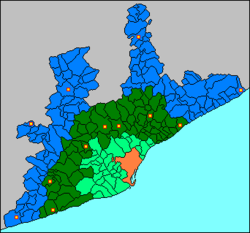- This article is about the metropolitan area. For the administrative area, see Àrea Metropolitana de Barcelona (AMB).
The Barcelona metropolitan area (Catalan: Àrea metropolitana de Barcelona, Spanish: Área metropolitana de Barcelona) is a metropolitan area in Catalonia, north of Spain, centered on the city of Barcelona. With a population of around 5 million, it's the most populous metropolitan area on the Mediterranean coast, and one of the biggest metropolises in Europe.
Overview
The urban area — core of metropolitan area of Barcelona has a population of 4,604,000[1] being the sixth-most populous urban area in the European Union after Paris, London, Ruhr area, Madrid and Milan. The Larger Urban Zone has a population of 4,440,629[2] according to Eurostat.
As stated by the Department of Economic and Social Affairs of United Nations, the metropolitan area of Barcelona has a population of 5,083,000,[3] according to the Organization for Economic Cooperation and Development has a population of 4,900,000[4] and according to the Eurostat has a population of 5,375,774.[5] According to Idescat has a population of 5,029,181,[6] according to BlatantWorld.com has a population of 4,992,778[7] and according to World Gazetteer has a population of 5,068,252.[8]
The Zones

Barcelona metropolitan area
| |
Population |
Area(km2) |
Density |
| Barcelona |
1.621.537 |
101 |
15.793 |
| First Zone |
1.598.534 |
532 |
2.923 |
| Second Zone |
1.481.937 |
1.362 |
1.070 |
| Third Zone |
747.810 |
2.273 |
329 |
|
5.355.127 |
4.268 |
1.255 |
- First Zone: consists of other municipalities (outside Barcelona) in an official union of adjacent cities and municipalities called the Àrea Metropolitana de Barcelona (AMB) (also Greater Barcelona) with a population of 3,220,071 in area of 636 km2 (density 5.010 hab/km2).
- Second Zone: considered as urban and metropolitan adjacent area. It forms a belt of cities: Vilanova i la Geltrú, Vilafranca del Penedès, Martorell, Terrassa, Sabadell, Granollers, Mataró and their respective areas of influence. The Generalitat projects the interconnection by means the Orbital Railway Line.
- Third Zone: considered territory of consolidated expansion. In this one the expansion passes to be of radial type, spreading across fluvial corridors or depressions, as in case of Manresa, Igualada and Vic, or continuing the coast, as in case of Blanes and El Vendrell.
Polynuclear Urban Region

P.U.R. of Barcelona
| |
Population |
Area(km2) |
Density |
| Barcelona metro |
5.355.127 |
4.268 |
1.255 |
| Tarragona Area |
411.876 |
656 |
628 |
| Girona Area |
336.218 |
1.081 |
311 |
|
6.103.221 |
6.005 |
1.016 |
According to the EURBANET project by Delft University of Technology[9] it speaks about polynuclear urban region when there exists a series of important urban centers that relate intensely among them and to the exterior. This one is the case of bordering zones to the urban region that they extend around the cities of Tarragona and Girona. They are areas with a great economic dependence and services to the capital. They are narrow corridors well communicated to Barcelona, both by highway and railroad, which there fuse the metropolitan areas of these cities with the urban region. The PUR of Barcelona would rely on so 6.103.221 people in an area of 6.005 km 2.
Barcelona Polynuclear Urban Region is conceived as "isolated islands of significant growth" which, may develop into zones of global economic integration. This is, however, not intended to happen at the cost of the global competitive position of the present core area.[10]
Municipalities of metropolitan area - population and area
First zone
Second zone
Third zone
Municipalities of Polynuclear Urban Region - population and area
Tarragona area
Girona area
See also
References
- ↑ Demographia: World Urban Areas, 2013
- ↑ "Urban Audit". Eurostat. 2006.
- ↑ United Nations Department of Economic and Social Affairs, World Urbanization Prospects (2009 revision), (United Nations, 2010), Table A.12. Data for 2007.
- ↑ Organization for Economic Cooperation and Development, Competitive Cities in the Global Economy, OECD Territorial Reviews, (OECD Publishing, 2006), Table 1.1
- ↑ "Population by sex and age groups on 1 January" - Eurostat, 2012
- ↑ Àmbit Metropolità. Sèrie temporal (Catalan)
- ↑ Most Populous Metropolitan Areas In Europe - blatantworld.com
- ↑ Europe: metropolitan areas - World Gazetteer, 2012
- ↑ EURBANET project
- ↑ EURBANET: Introduction Theoretical Framework - Delft University of Technology, 2002



